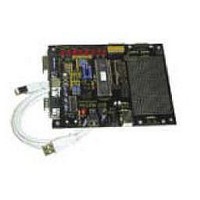DM163010 Microchip Technology, DM163010 Datasheet - Page 21

DM163010
Manufacturer Part Number
DM163010
Description
BOARD DEMO PICDEM USB
Manufacturer
Microchip Technology
Datasheet
1.DM163010.pdf
(80 pages)
Specifications of DM163010
Processor To Be Evaluated
PlC16C745/765
Interface Type
USB
Lead Free Status / RoHS Status
Lead free / RoHS Compliant
Lead Free Status / RoHS Status
Lead free / RoHS Compliant, Lead free / RoHS Compliant
2.2
©
2001 Microchip Technology Inc.
PS/2 Keyboard/Mouse - USB Translator
2.1.7
2.2.1
2.2.2
2.2.3
Vendor/Product Identification
Besides the report information, the descriptors also contain manufacturing
Introduction
This is the demonstration firmware that is programmed into the PIC16C765
About the PS/2 Port
IBM
Hardware Implementation
The PS/2 port is a 6-pin DIN which only uses 4 pins. The pins are used for
and product identification codes. Microchip has a registered Vendor ID with
the USB IF forum, which identifies Microchip’s Vendor ID as 0x04D8. You are
allowed to use this ID for your own testing, but you may not ship any products
with this code without written permission from Microchip. Microchip has
defined product ID’s for each demonstration code included in this kit. As addi-
tional demonstration devices are released, Microchip will ensure that no
duplicate ID’s are used.
and installed on the PICDEM™ USB demonstration board. The PS/2 connec-
tor was added so PS/2 mice and keyboards could be translated to USB.
Again, this is a straightforward application intended to provide practice with
device descriptors. The PS/2 interface is a synchronous serial interface with
different data protocols for keyboards and mice. Device descriptors in the
PICmicro microcontroller allows the unit to report itself as either a keyboard or
a mouse. When a mouse is attached to a PS/2 port, it identifies itself as a
mouse. When the PICmicro MCU receives this identification, it will perform a
soft detach from the USB bus and re-attach as a mouse. When the PICmicro
MCU identifies the PS/2 device as a keyboard, it will perform a soft detach
and re-attach as a keyboard. Using soft detach may be a useful feature in
your application, so you can practice using it with this example.
ers. This port is a synchronous serial port clocked by the PS/2 device (key-
board/mouse). Generally, PC’s have two PS/2 ports labeled as keyboard or
mouse. The PICDEM™ USB only has one PS/2 port. Since the hardware is
the same, either the keyboard or mouse can be used, simply by interpreting
the data correctly.
power, ground, clock, and data. Power and ground pins are directly tied to V
and V
switches from other I/O pins.The clock pin is connected to RC0, while the data
pin is connected to RC1. The PS/2 device clocks the host even when it is receiv-
ing data. The data pin is used to send and receive data from the keyboard.
Note:
®
originally developed the PS/2 port for use on its PS/2 family of comput-
SS
. If power management is desired, the power pins must be driven via
It may be necessary to attach 110 kOhm pull-down resistors on
RC0 and RC1, in order for auto-detect to work without pressing
MCLR between plugging and unplugging PS/2 devices.
USB Demonstration Code
DS41174A-page 17
DD











